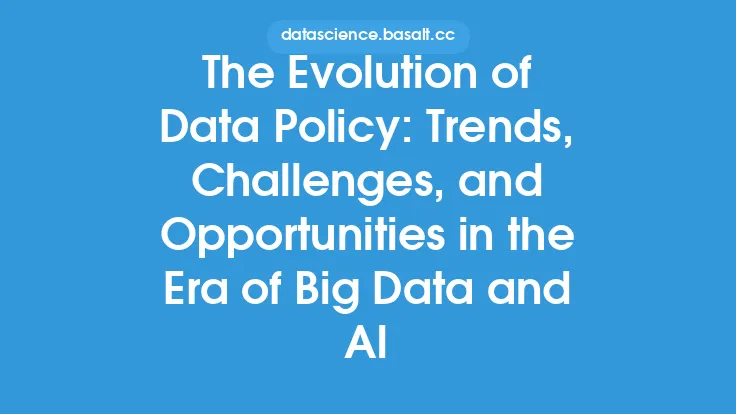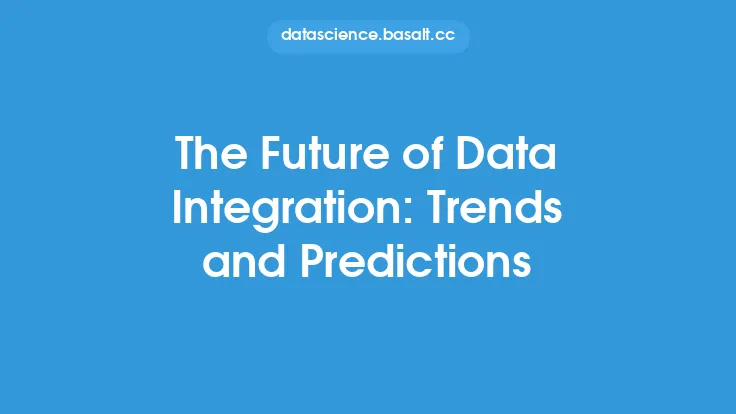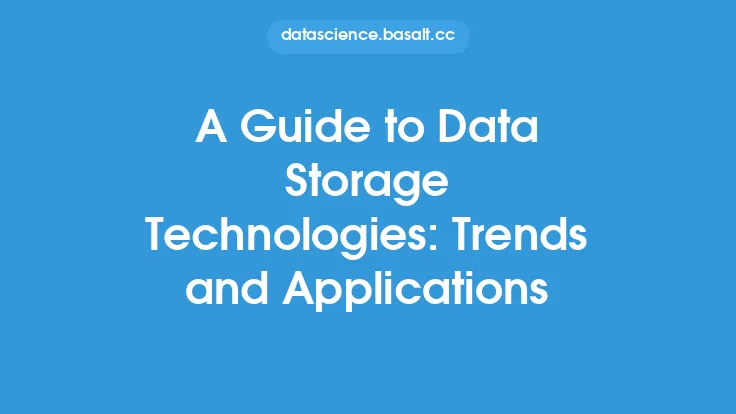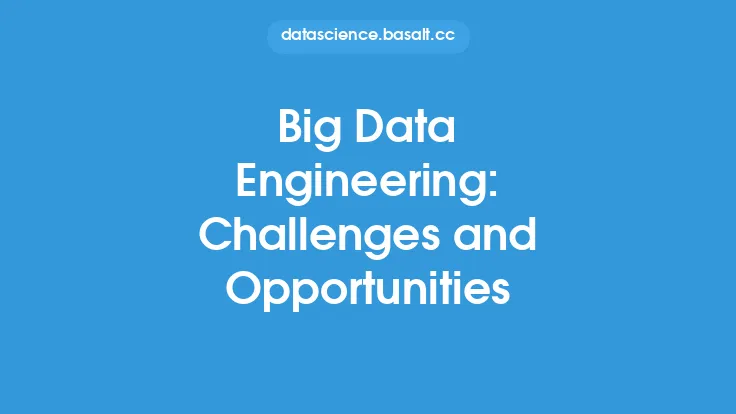The field of big data engineering is rapidly evolving, driven by the increasing volume, variety, and velocity of data being generated by organizations across various industries. As a result, big data engineers are faced with the challenge of designing, building, and maintaining scalable, efficient, and secure data systems that can handle the complexities of big data. In this article, we will explore the current trends and future directions in big data engineering, highlighting the key technologies, tools, and techniques that are shaping the field.
Introduction to Big Data Engineering Trends
Big data engineering trends are influenced by the growing demand for real-time data processing, advanced analytics, and artificial intelligence (AI). The increasing adoption of cloud computing, the Internet of Things (IoT), and social media has led to an explosion of data, making it essential for organizations to invest in big data engineering. Some of the key trends in big data engineering include the use of distributed computing frameworks, NoSQL databases, and data lakes. Additionally, the rise of containerization, serverless computing, and edge computing is transforming the way big data systems are designed and deployed.
The Role of Distributed Computing Frameworks
Distributed computing frameworks, such as Apache Hadoop, Apache Spark, and Apache Flink, are the backbone of big data engineering. These frameworks enable the processing of large datasets across a cluster of nodes, making it possible to handle the scale and complexity of big data. Distributed computing frameworks provide a range of benefits, including scalability, fault tolerance, and high-performance processing. They also support a variety of data processing paradigms, including batch processing, stream processing, and interactive querying. As the volume and velocity of data continue to increase, distributed computing frameworks will play an even more critical role in big data engineering.
The Emergence of Cloud-Native Big Data Systems
Cloud-native big data systems are designed to take advantage of the scalability, flexibility, and cost-effectiveness of cloud computing. These systems use cloud-based infrastructure and services, such as Amazon Web Services (AWS), Microsoft Azure, and Google Cloud Platform (GCP), to build and deploy big data applications. Cloud-native big data systems provide a range of benefits, including reduced costs, increased agility, and improved scalability. They also enable the use of cloud-based services, such as data warehousing, data lakes, and machine learning, to support advanced analytics and AI applications. As the adoption of cloud computing continues to grow, cloud-native big data systems will become increasingly important in big data engineering.
The Importance of Data Governance and Security
Data governance and security are critical components of big data engineering. As organizations collect and process large amounts of data, they must ensure that the data is accurate, complete, and secure. Data governance involves the development of policies, procedures, and standards for data management, including data quality, data privacy, and data security. Data security involves the use of technologies and techniques, such as encryption, access control, and authentication, to protect data from unauthorized access or malicious attacks. As the volume and variety of data continue to increase, data governance and security will become even more critical in big data engineering.
The Future of Big Data Engineering
The future of big data engineering will be shaped by a range of technologies and trends, including AI, machine learning, and the IoT. As AI and machine learning continue to evolve, they will play an increasingly important role in big data engineering, enabling the development of more sophisticated data analytics and AI applications. The IoT will also drive the growth of big data engineering, as the increasing number of connected devices generates large amounts of data that must be collected, processed, and analyzed. Additionally, the use of edge computing, serverless computing, and containerization will continue to transform the way big data systems are designed and deployed.
The Impact of Artificial Intelligence and Machine Learning
Artificial intelligence (AI) and machine learning (ML) are revolutionizing the field of big data engineering. AI and ML enable the development of more sophisticated data analytics and AI applications, including predictive analytics, natural language processing, and computer vision. AI and ML also enable the automation of data processing and analysis, reducing the need for manual intervention and improving the accuracy and efficiency of data-driven decision making. As AI and ML continue to evolve, they will play an increasingly important role in big data engineering, enabling the development of more advanced data analytics and AI applications.
The Role of Edge Computing in Big Data Engineering
Edge computing is a distributed computing paradigm that involves processing data at the edge of the network, closer to the source of the data. Edge computing is particularly useful in big data engineering, as it enables the processing of large amounts of data in real-time, reducing the latency and improving the performance of data analytics and AI applications. Edge computing also enables the use of IoT devices, such as sensors and cameras, to generate and process data in real-time. As the adoption of edge computing continues to grow, it will play an increasingly important role in big data engineering, enabling the development of more sophisticated data analytics and AI applications.
The Importance of Containerization and Serverless Computing
Containerization and serverless computing are transforming the way big data systems are designed and deployed. Containerization involves the use of containers, such as Docker, to package and deploy applications, making it easier to manage and orchestrate big data systems. Serverless computing involves the use of cloud-based services, such as AWS Lambda, to run applications without the need for server management, making it easier to scale and deploy big data systems. As the adoption of containerization and serverless computing continues to grow, they will play an increasingly important role in big data engineering, enabling the development of more scalable, flexible, and cost-effective big data systems.
Conclusion
In conclusion, big data engineering is a rapidly evolving field, driven by the increasing volume, variety, and velocity of data being generated by organizations across various industries. The current trends and future directions in big data engineering are shaped by a range of technologies and trends, including distributed computing frameworks, cloud-native big data systems, data governance and security, AI, ML, edge computing, containerization, and serverless computing. As the field of big data engineering continues to evolve, it is essential for big data engineers to stay up-to-date with the latest technologies and trends, and to develop the skills and expertise needed to design, build, and maintain scalable, efficient, and secure big data systems.





